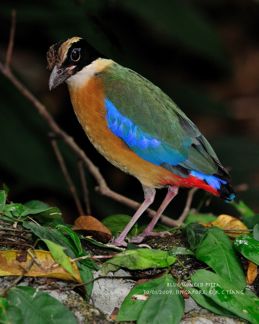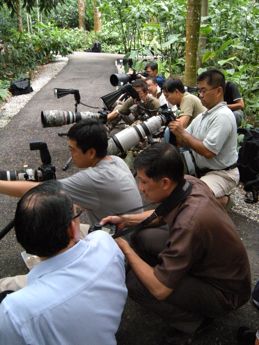“It is this time of the year again that birds like the Hooded (Pitta sordida) and Blue-winged Pittas (Pitta moluccensis) (above left) would pay our Singapore Botanic Gardens a visit on the way back up, or is it their turn around point before making their way back up north, to the Indian sub-continent, SW China. And as always, some of these birds very quickly get used to the presence of a great number of people and their camera gear pointing at them, with flashes blazing away. These lovely birds provide our photographers a great opportunity to put into practice their skills.
“When news spread that the pitta was in the Botanic Gardens, the gathering crowd of about 15 to 20 photographers at any one time was about as much as the small area and the path running through could take (above right). However do bear in mind the pitta was not at all disturbed by our presence. In actual fact it enjoyed the attention and at times it came up so close to us that we were not able to focus our cameras on it. The pitta also had some competition from a Red-legged Crake (Rallina fasciata) which also wanted some attention. When the pitta appeared, the crake got very angry and chased it away, the usual way birds do with head low down and pointed forward like a charging battering ram.
“But I guess the Red-legged Crake wanted all of the mealworms to himself, but we photographers did not want the crake around and some tried to shoo it away with limited success. I have no objections to feeding birds with mealworms or other bird feeds. In actual fact feeding the birds would help to prepare them for the long journey back. While I was in London, most of the gardens there had bird feeders, not one but a couple with differing kinds of bird food. It also helps the birds to survive the winter months, where food can be really difficult to get.
“And coming back to the crowd of photographers, we have to be very careful where we place our backsides, and not to sit on the plants, thus flattening and killing them. As some of us know, the NParks people were very annoyed and had taken down a few of the unruly photographers’ particulars, and pictures of the culprits sitting on the plants were also taken as evidence. At this point in time I do not know what kind of action the NParks people are going to take.”
KC Tsang
5th February 2009
Our bird specialist R Subaraj sent in this note: “…our pittas are likely to hail from SW China. Indian subcontinent birds migrate elsewhere, not to south-east Asia. I disagree with feeding pittas with mealworms on the ground. Should be on feeders a bit off the ground. Ground feeding could attract snakes to the area. What would happen if some mealworms got away? As for supplementing a migrants diet, this helps in some parts of the US due to the cold weather. This should not apply here.”
NOTE:
Lim Soh Har, the Asst Director (Operations) of NParks informed that the photographers concerned were given a warning. Photographers are reminded not to trample on the plants in their excitement to photograph rare birds that take refuge in the Botanic Gardens, parks or nature reserves. They should stay on the road, an example shown by the more experienced and responsible photographers in the image at the top (right).











2 Responses
I have posted a video in Borneo bird club Facebook page on seeing a blue winged pitta at our backyard here in kota Kinabalu. Would you want to come and see it is still here now making loud call for over 1 month in this little tiny forests I hope they conserve reserve this little forest because so many bird species live here including blue winged pitta and black magpie and lesser coucal, pied triller, common iora, magpie robin, pink-necked green pigeon..